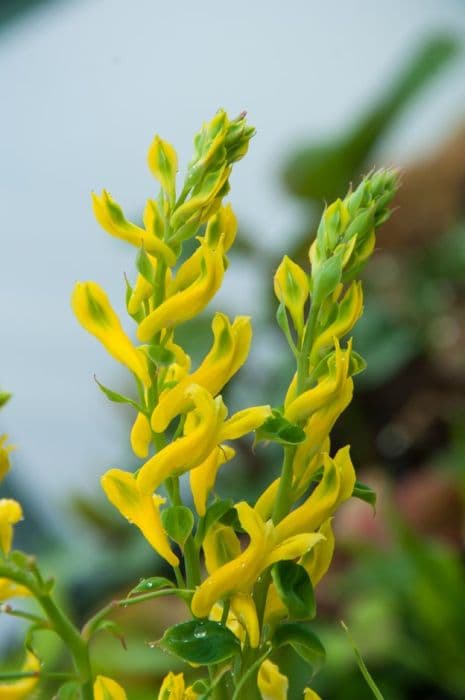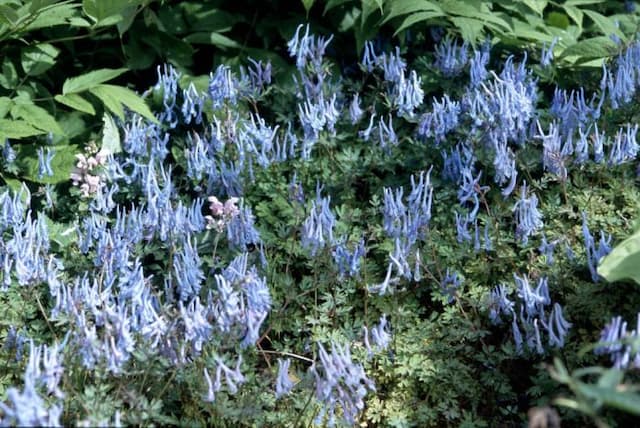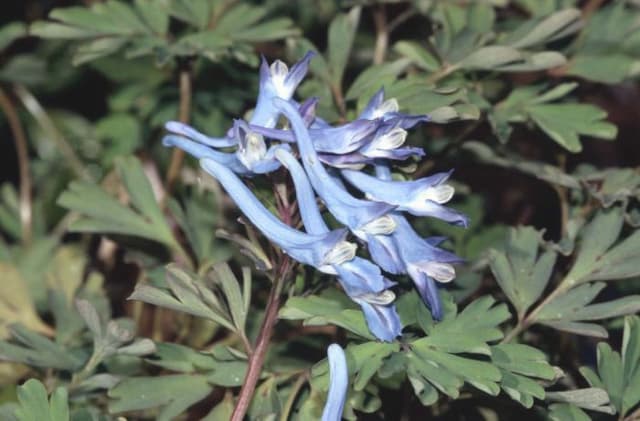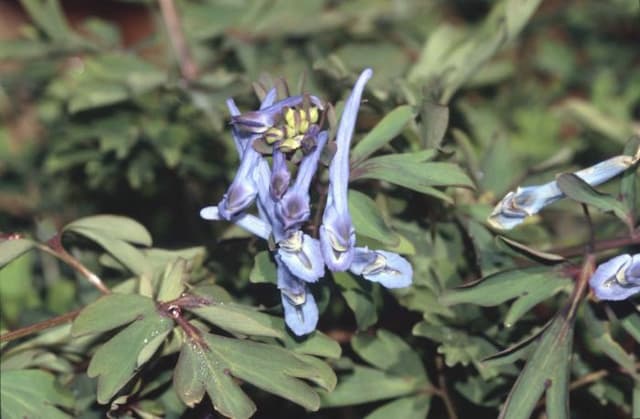Fumewort Corydalis solida subsp. solida 'Beth Evans'

ABOUT
Corydalis 'Beth Evans' is a charming plant known for its delicate and attractive appearance. It features a cluster of tubular flowers, which exude an aura of softness and femininity. The blossoms are notably colored in a delightful shade of pink, with subtle hints of lighter and deeper tones that provide a nuanced and attractive visual appeal. These flowers are neatly arranged in a raceme, presenting an orderly and aesthetically pleasing display. The foliage of Corydalis 'Beth Evans' comprises compound leaves that are intricately divided into smaller leaflets. These leaflets bear a resemblance to lace, with fine and intricate textures that add to the plant's overall delicate impression. The color of the leaves is a bright green, offering a fresh and vibrant contrast to the pink hues of the flowers. This plant has a graceful and spreading habit, with stems that elegantly support both the flowers and leaves. Together, the blooms and foliage create a harmonious visual symphony that's delightful to behold in a garden setting. Impressively, the visual spectacle of 'Beth Evans' comes to life early in the growing season, offering an early burst of color and beauty. Ideal for woodland gardens or dappled shade areas, Corydalis 'Beth Evans' presents itself as a plant that's both beautiful and capable of adding a touch of elegance to any garden space it graces. Its overall appearance can be summarized as delicate, colorful, and intrinsically charming, thanks to its soft pink blooms and lacy green leaves.
About this plant
 Names
NamesFamily
Papaveraceae.
Synonyms
Fumewort, Beth Evans Corydalis.
Common names
Corydalis solida var. densiflora, Corydalis solida var. incisa, Corydalis halleri, Corydalis solida subsp. halleri
 Toxicity
ToxicityTo humans
The plant commonly known as Fumewort has been noted for its variety of alkaloids, some of which can be toxic. While specific toxicity data on Corydalis solida subsp. solida 'Beth Evans' is limited, members of the Corydalis genus can be poisonous if ingested in large quantities. However, the toxicity is generally low, and it does not usually pose a serious risk to humans. If ingested, symptoms may include mild gastrointestinal upset. It is always best to err on the side of caution and avoid ingesting any part of plants not known to be safe for consumption.
To pets
Similar to its effects on humans, Fumewort could potentially cause mild toxicity in pets if ingested, due to the presence of various alkaloids found in the plant. Symptoms of poisoning in pets might include gastrointestinal upset such as vomiting or diarrhea. Although it is unlikely to be fatal, it is still recommended to keep pets from consuming this plant to avoid any potential adverse effects. If you suspect your pet has ingested Fumewort, consult with a veterinarian to ensure appropriate care.
 Characteristics
CharacteristicsLife cycle
Perennials
Foliage type
Deciduous
Color of leaves
Green
Flower color
Pink
Height
8 inches (20 cm)
Spread
6 inches (15 cm)
Plant type
Bulb
Hardiness zones
5
Native area
Europe
Benefits
 General Benefits
General Benefits- Aesthetic Appeal: Corydalis solida 'Beth Evans', commonly known as Fumewort, adds a delicate and attractive pop of pink flowers to gardens in the early spring.
- Easy to Grow: Fumewort is relatively easy to cultivate and can thrive in a range of soil types, as long as the soil is well-drained.
- Pollinator Attraction: The flowers of Fumewort are known to attract pollinators like bees, which are crucial for the health of the ecosystem.
- Shade Tolerance: This plant is suitable for shaded areas of the garden, where other plants might struggle to grow.
- Compact Size: With its compact growth habit, Fumewort is suitable for small gardens or for underplanting among taller plants.
- Spring Interest: Fumewort blooms early in the spring, providing interest during a time when many other plants are not yet flowering.
- Low Maintenance: After establishment, Fumewort requires minimal maintenance, which is ideal for gardeners who prefer low-maintenance plants.
- Naturalizing: Fumewort has the ability to naturalize by self-seeding, creating a charming, natural look in woodland or meadow-style gardens.
 Medical Properties
Medical Properties- This plant is not used for medical purposes
 Air-purifying Qualities
Air-purifying QualitiesThis plant is not specifically known for air purifying qualities.
 Other Uses
Other Uses- Corydalis solida 'Beth Evans', commonly known as Fumewort, can be used in shaded rock gardens for its attractive foliage and early spring flowers.
- Fumewort's tuber-like roots can be a natural soil aerator, providing small channels that can enhance soil drainage and air penetration in dense soils.
- The plant can be cultivated as part of a woodland garden theme, mimicking its natural habitat and contributing to biodiversity.
- Fumewort can serve as a living mulch, its dense growth suppressing weeds and conserving soil moisture in garden beds.
- When planted en masse, Fumewort can establish a stunning ground cover, creating a carpet of color in early spring.
- The plant's ability to go dormant after flowering makes it a suitable companion for late-emerging perennials in a mixed border.
- Due to its ephemeral nature, Fumewort can share space with summer bulbs, providing interest before the bulbs emerge.
- The seed pods of Fumewort can add an intriguing textural element to dried flower arrangements.
- As an early source of nectar, Fumewort can offer a valuable food source for pollinators, especially in cooler climates.
- Cultivating Fumewort can serve as an educational tool for gardeners, providing insight into the growth habits of ephemeral woodland plants.
Interesting Facts
 Feng Shui
Feng ShuiThe Fumewort is not used in Feng Shui practice.
 Zodiac Sign Compitability
Zodiac Sign CompitabilityThe Fumewort is not used in astrology practice.
 Plant Symbolism
Plant Symbolism- Hope: Corydalis 'Beth Evans', with its early spring blooms, often symbolizes hope as it heralds the end of winter and the coming of better times.
- Prosperity: The vigorous growth and profusion of flowers can represent prosperity and abundance.
- Joy: The bright, pleasant color of 'Beth Evans' flowers is frequently associated with joy and happiness.
- Resilience: Able to bloom in cool temperatures, the corydalis signifies resilience and the ability to thrive despite challenges.
 Water
WaterFumewort, commonly known as 'Beth Evans', prefers evenly moist soil, especially during its active growth in the spring. Watering should be done when the top inch of soil feels dry to the touch. An approximate guide is to water once or twice a week, using about 1 gallon of water per square yard of soil each month during the growing season. During dormancy in the late summer, watering should be reduced to prevent the soil from becoming waterlogged, which can cause the tubers to rot.
 Light
LightFumewort 'Beth Evans' thrives in partial shade, making it suitable for a spot that receives filtered sunlight or morning sun followed by afternoon shade. It can also grow successfully in full shade, where it gets dappled sunlight for a few hours a day. Avoiding direct, harsh afternoon sun is key to prevent the leaves from scorching.
 Temperature
TemperatureFumewort 'Beth Evans' can tolerate temperatures as low as 20°F but grows best when daytime temperatures are between 50°F and 65°F. It can survive short spells of frost, but prolonged exposure to temperatures below the minimum can be detrimental to the plant. The ideal range ensures the plant's health and promotes its delicate spring blooms.
 Pruning
PruningPruning is not typically required for Fumewort 'Beth Evans' as it is a herbaceous perennial that naturally dies back after flowering. Deadheading, or the removal of spent flowers, may encourage additional blooming and prevent self-seeding. The best time for pruning is after flowering when foliage starts to yellow, usually in late spring or early summer.
 Cleaning
CleaningAs needed
 Soil
SoilBeth Evans Corydalis thrives in a well-draining soil mix rich in organic matter with a pH between 6.0 and 7.5. A mixture of loam, peat, and sand in equal parts can create the optimal growing condition for this plant by ensuring proper drainage while retaining adequate moisture.
 Repotting
RepottingFumewort ('Beth Evans') does not typically require frequent repotting; it is generally best to repot once every 2-3 years to refresh the soil and accommodate growth.
 Humidity & Misting
Humidity & MistingFumewort ('Beth Evans') prefers moderate humidity levels but is tolerant of a range of conditions, making it relatively easy to grow in typical garden environments without specific humidity requirements.
 Suitable locations
Suitable locationsIndoor
Grow in bright, indirect light with well-draining soil.
Outdoor
Plant in partial shade with well-drained soil and mulch.
Hardiness zone
5-7 USDA
 Life cycle
Life cycle'Beth Evans' Fumewort begins its life as a tuber buried in the soil, which sprouts in early spring, producing clumps of feathery, blue-green foliage and pink flowers. After blooming, the plant sets seed, which are dispersed in the area around the parent plant to produce new individuals. Once the flowering period is over, the foliage begins to yellow and the plant enters a period of dormancy through late spring and summer, withdrawing nutrients back into the tuber. During dormancy, the plant is underground and inactive, evading the harsher conditions of summer. In autumn, the tuber may begin to grow tiny roots in preparation for the spring, but it remains largely dormant until the temperatures and light conditions are favorable again. With the return of suitable conditions in the following spring, the cycle repeats with the emergence of new growth from the tuber.
 Propogation
PropogationPropogation time
Spring
The most popular method of propagating the Corydalis solida 'Beth Evans' is by dividing its tubers. This procedure is ideally carried out in late summer after the foliage has died back or in early fall before the ground freezes. Carefully dig up the clump of tubers, trying to minimize damage to them. You'll find small daughter tubers attached to the parent; gently break these away. The tubers can then be planted immediately; they should be placed about 2 inches deep (5 cm) and spaced roughly 3 inches apart (7.6 cm). Ensure that the planting area is well-draining and rich in organic matter to promote growth. Water in the newly planted tubers to settle the soil around them and to help kickstart their development before they go dormant for the winter.









